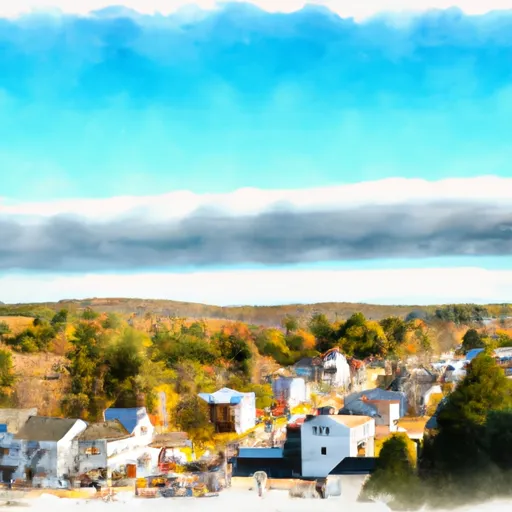-
 Snoflo Premium
Snoflo Premium
Get unlimited access to all our content
With no Ad interruptions! - Start Your Free Trial Login with existing account
Hubbardston
Eden Index
Climate
8.2
•
Recreation
3.8
•
Community
1.7
•
Safeguard
5.0/10

Hubbardston is a charming town located in Worcester County, Massachusetts. The climate in Hubbardston is characterized by warm summers and cold winters. Average temperatures range from around 20°F (-6.7°C) in winter to about 80°F (26.7°C) in summer. The town experiences moderate precipitation throughout the year.
Hubbardston is home to many pristine lakes and ponds, including Comet Pond, Cushman Pond, and Willard Brook Reservoir. These water bodies are not only scenic but also offer various outdoor recreation opportunities. Fishing enthusiasts can try their luck at catching bass, trout, and other freshwater fish. Boating and kayaking are popular activities, allowing visitors to explore the tranquil waters while enjoying the surrounding natural beauty.
The Hubbardston State Forest is another notable outdoor attraction. This 3,500-acre forest offers numerous hiking trails, including the popular Midstate Trail, allowing nature lovers to enjoy picturesque views of the landscape and observe wildlife. During winter, the forest becomes a haven for cross-country skiing and snowshoeing enthusiasts.
With its favorable climate, beautiful hydrology constituents, and diverse outdoor recreation opportunities, Hubbardston, Massachusetts, is an idyllic destination for nature enthusiasts and those seeking outdoor adventures.
What is the Eden Index?
The Snoflo Eden Index serves as a comprehensive rating system for regions, evaluating their desirability through a holistic assessment of climate health, outdoor recreation opportunities, and natural disaster risk, acknowledging the profound impact of these factors on livability and well-being.
Climate Health Indicator (CHI): 8.2
Hubbardston receives approximately
1222mm of rain per year,
with humidity levels near 72%
and air temperatures averaging around
8°C.
Hubbardston has a plant hardyness factor of
5, meaning
plants and agriculture in this region thrive during a short period during spring and early summer. Most
plants will die off during the colder winter months.
By considering the ideal temperature range, reliable water supplies, clean air, and stable seasonal rain or snowpacks, the Climate Health Indicator (CHI) underscores the significance of a healthy climate as the foundation for quality living.
A healthy climate is paramount for ensuring a high quality of life and livability in a region, fostering both physical well-being and environmental harmony. This can be characterized by ideal temperatures, reliable access to water supplies, clean air, and consistent seasonal rain or snowpacks.
Weather Forecast
Streamflow Conditions
Lower Connecticut
Area Rivers
Lower Connecticut
Snowpack Depths
Lower Connecticut
Reservoir Storage Capacity
Lower Connecticut
Groundwater Levels
Recreational Opportunity Index (ROI): 3.8
The Recreational Opportunity Index (ROI) recognizes the value of outdoor recreational options, such as parks, hiking trails, camping sites, and fishing spots, while acknowledging that climate plays a pivotal role in ensuring the comfort and consistency of these experiences.
Access to outdoor recreational opportunities, encompassing activities such as parks, hiking, camping, and fishing, is crucial for overall well-being, and the climate plays a pivotal role in enabling and enhancing these experiences, ensuring that individuals can engage in nature-based activities comfortably and consistently.
Camping Areas
| Campground | Campsites | Reservations | Toilets | Showers | Elevation |
|---|---|---|---|---|---|
| Lake Dennison State Park | 150 | 829 ft | |||
| Tully Lake | None | 654 ft | |||
| Otter River State Forest | 85 | 864 ft |
Nearby Ski Areas
Catastrophe Safeguard Index (CSI):
The Catastrophe Safeguard Index (CSI) recognizes that natural disaster risk, encompassing floods, fires, hurricanes, and tornadoes, can drastically affect safety and the overall appeal of an area.
The level of natural disaster risk in a region significantly affects safety and the overall livability, with climate change amplifying these risks by potentially increasing the frequency and intensity of events like floods, fires, hurricanes, and tornadoes, thereby posing substantial challenges to community resilience and well-being.
Community Resilience Indicator (CRI): 1.7
The Community Resilience Indicator (CRI) recognizes that education, healthcare, and socioeconomics are crucial to the well-being of a region. The CRI acknowledges the profound impact of these elements on residents' overall quality of life. By evaluating educational resources, healthcare accessibility, and economic inclusivity, the index captures the essential aspects that contribute to a thriving community, fostering resident satisfaction, equity, and social cohesion.

